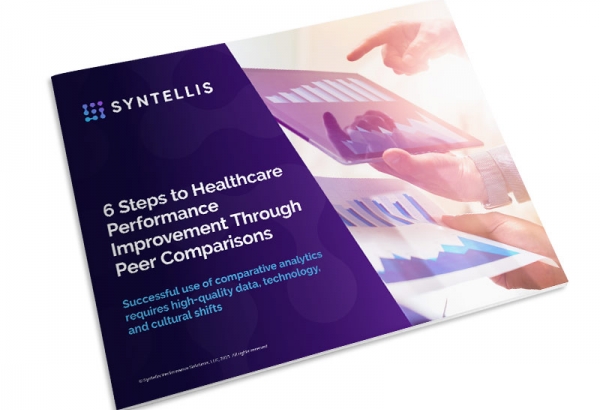The Great Resignation continues with millions of Americans quitting their jobs in search of higher wages and better working conditions, with 4.4 million employees resigning this past September alone. Healthcare workers traumatized by the pandemic and stretched thin by surging COVID-19 cases are also seeking greener pastures, with an estimated half a million workers quitting since February 2020, according to the U.S. Bureau of Labor Statistics.
Hospitals and health systems face a crisis as the global supply chain constraints paired with these staffing shortages lead to mounting increases in expenses. With closed quarters for winter and the new Omicron variant making its presence known in the U.S., healthcare providers face further pressure with possible surges to come this winter.
Over the past several months, Syntellis has published the Syntellis Performance Trends, a report capturing near real-time data from over 1,000 hospitals and 135,000 healthcare providers nationwide. As Omicron cases start to rise, we can look at labor data from the past several months to anticipate how the variant could impact health systems and how they can account for the continued staffing shortages.
Lessons from Delta
In the summer of 2021, there was a surge of COVID-19 cases, jumping 1,000% nationwide from July 1 - August 31, with the Delta variant accounting for 98% of new cases. As hospitals prepare for another surge, it’s critical to look at Delta’s impact at its onset.
Intensive care units (ICUs) volumes picked up alongside the increase in the number of individuals suffering severe COVID-19 complications. The September Syntellis Performance Trends report revealed that Pediatric ICUs, in particular, saw dramatic volume increases as Delta led to higher levels of child hospitalizations, with Patient Days jumping 35% in August versus pre-pandemic levels. Adult ICUs also saw sharp increases, with Medical ICU Patient Days spiking 19% in August versus the same period in 2019 and approaching peaks seen during the previous winter’s surge.
With this rise in Patient Days, hospitals faced significant overtime challenges, with Medical ICUs seeing a national median overtime percentage rising 2.4% and as much as 5.7% for the worst-hit hospitals. At a regional level, median overtime percentages increased 4.7%, 4.1%, and 3.7% over the same period in the Great Plains, South, and West, respectively. Hospitals in the South had the largest overtime increase — 8.2% — among hospitals in the bottom quartile.
If Delta’s impact is any indication of what hospitals can expect with other potential surges, healthcare systems will need to be prepared to account for increased volumes and shrinking staff.
The Labor Crunch Continues
Following the initial Delta surge, healthcare organizations faced rapidly rising labor expenses as they were forced to compete for a shrinking labor pool. As noted in the October Syntellis Performance Trends report, ICUs continued to see high patient volumes even as overall COVID-19-related hospitalizations began to taper off, with new hospital admissions of patients with COVID-19 dropping 35% throughout September after spiking more than 500% from mid-June to early September. However, ICU Patient Days increased 27.8% in Medical ICUs, 23.9% in Surgical ICUs, and 17.3% in Pediatric ICUs compared to pre-pandemic levels. With these numbers, hospitals’ Labor Expense per Adjusted Discharge jumped 20.4% compared to pre-pandemic levels in September 2019 despite a 4.6% decrease in hospital staff per patient.
A prime example of the labor shortage’s crunch was within respiratory care departments, which saw steady increases in the hourly rate paid for respiratory therapists, keeping Labor Expense per Procedure high, even as volumes have recovered. The hourly rate for respiratory therapists was up 10.2% in September compared to September 2019. The median Labor Expense per Procedure was 21.9% higher than the same month in 2019 and has hovered about 20% above pre-pandemic levels since July 2020.
In the October report, Judy Stroot, R.N., BSN, M.A., NEA-BC, managing director at Huron, said, “Hospitals continue to face significant challenges in retaining current employees and recruiting new employees. Organizations are using this time to take a step back and assess their core talent strategy and tactics, with a significant emphasis being placed on introducing innovative solutions to care delivery and re-examining total rewards offerings. Balancing near-term demands with long-term financial sustainability will be a critical success factor for healthcare organizations striving to emerge from this pandemic on solid financial footing.”
With Tight Competition Comes Higher Rates
The most recent Syntellis Performance Trends report shows that hourly rates for registered nurses (RNs) are also on the rise, with increases of 8.8% for Emergency Room RNs, 8.7% for Acute Medical or Surgical RNs, 8.5% for Intermediate Care RNs, and 8% for Intensive Care RNs. Additionally, hourly rates for respiratory therapists continued an upward trajectory, jumping 11.5% in October compared to 2019 levels, despite the growth in respiratory procedures slowing down. This led to the Labor Expense per Procedure jumping 27.5% in October compared to October 2019, up from a 21.9% increase in September versus September 2019.
These numbers illustrate the impact of the labor shortage as wages and labor costs continue to climb despite waning patient demand or decreased staffing levels. With pandemic-related burnout and an abundance of other opportunities, healthcare providers are scrambling to attract and retain talent amidst the Great Resignation while a new variant looms.
Huron managing director Tonia Breckenridge stated in November’s report, “Healthcare organizations need to put an emphasis on rewarding and recognizing top performers in ways that are meaningful, including creating a safe environment where individuals are encouraged to challenge the status quo, think innovatively and bring new solutions forward, and addressing poor performers. Engaging top performers to solve for the issues we face today will have long term impact in redesigning the care model for the future.”
Planning ahead
These rising labor expenses continue to challenge an industry already strained by the ongoing pressures of the COVID-19 pandemic. Labor shortages and global supply chain challenges are hitting healthcare providers amid a pending surge. It will be critical that organizations adapt to build financial health and stability in a post-COVID environment as the current trends are not sustainable.
To face the labor shortage head-on, healthcare leaders need an in-depth understanding of the changes to the industry’s financial landscape. As utilized in the Syntellis Performance Trends report and Axiom™ Comparative Analytics, benchmarking data can identify opportunities for improvement and effectively guide recovery efforts. With data-driven insights, the nation’s healthcare industry can ensure exceptional patient care and long-term financial sustainability.
Learn more about hospital & physician benchmarking

Improving Physician Profitability with Market Trends and Comparative Analysis

3 Ways to Improve Forecast Accuracy With Comparative Analytics


